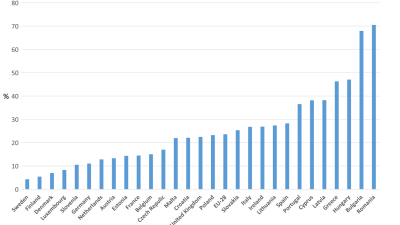Global poverty is increasingly becoming a matter of domestic inequality, according to a new study. This is because most of the world population living in poverty (by income and multi-dimensional poverty measures) now live in countries categorised by the World Bank as middle-income countries (MICs) rather than low-income countries (LICs).
Key points
- The incidence of income poverty at $1.25 a day has fallen from 43 per cent in 1990 to 22 per cent in 2008, and is projected to fall to 16 per cent by 2015.
- However, if China is removed, the total number of people under $1.25 a day has barely changed since 1990, while the number of people under the $2 poverty line has slightly increased.
- The discussion of poverty in MICs should not distract from the reality that LICs typically have higher rates of poverty incidence. That said, poverty rates in MICs remain surprisingly high given average income and income growth.
- This new 'geography of poverty' raises questions about the usefulness of country classifications, and about the types of economic growth that lead some countries to reduce the number of people in extreme poverty and other countries not to.
- Although the thresholds do not mean a sudden change in countries when a line is crossed in per capita income, substantially higher levels of average per capita income imply substantially more domestic resources available for poverty reduction and – most importantly for donors – the current aid system does treat countries differently depending on whether they are LICs or MICs.
Source: Andy Sumner, Global Poverty Reduction: The Last 20 Years and the Next 20 Years, European Association of Development Research and Training Institutes
Link: Report



 PSE:UK is a major collaboration between the University of Bristol, Heriot-Watt University, The Open University, Queen's University Belfast, University of Glasgow and the University of York working with the National Centre for Social Research and the Northern Ireland Statistics and Research Agency. ESRC Grant RES-060-25-0052.
PSE:UK is a major collaboration between the University of Bristol, Heriot-Watt University, The Open University, Queen's University Belfast, University of Glasgow and the University of York working with the National Centre for Social Research and the Northern Ireland Statistics and Research Agency. ESRC Grant RES-060-25-0052.






